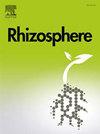不同磷含量下接种了丛枝菌根真菌的香茅的精油植物化学和抗真菌活性
IF 3.4
3区 生物学
Q1 PLANT SCIENCES
引用次数: 0
摘要
本研究旨在探讨在低磷和高磷水平下,将柠檬香茅(Cymbopogon citratus,柠檬草)与丛生菌根真菌(AMF)Rhizophagus clarus 和 Claroideoglomus etunicatum 接种,对精油(EO)含量、成分和四种镰刀菌属植物病原真菌分离物的最低抑制浓度(MIC)的影响。精油含量是通过水蒸馏法获得的,然后使用气相色谱-质谱法评估化学成分,MIC 是通过肉汤中的微量稀释法获得的。与低 P 条件下未接种 C. etunicatum 相比,高 P 条件和接种 C. etunicatum 使环氧乙烷含量增加了 2.5 倍。主要成分为香茅醇、香叶醇、柠檬醛、橙花醛和香叶醛。柠檬草环氧乙烷显示出对四种植物病原真菌分离物的最低抑菌浓度。因此,次生代谢物受 P 水平和 AMF 接种的影响,增加了环氧乙烷的含量(直到 2.5 倍)、化学成分(柠檬醛、橙花醛和香叶醇)和 MIC。本文章由计算机程序翻译,如有差异,请以英文原文为准。
Essential oil phytochemistry and antifungal activity of lemongrass inoculated with arbuscular mycorrhizal fungi under different phosphorous levels
This study aimed to investigate the effect of inoculating Cymbopogon citratus (lemongrass) with arbuscular mycorrhizal fungi (AMF) Rhizophagus clarus and Claroideoglomus etunicatum under low and high phosphorus (P) levels on essential oil (EO) content, composition, and minimum inhibitory concentration (MIC) for four isolates of phytopathogenic fungi of the genus Fusarium. The EO content was obtained by the hydrodistillation process, followed by the evaluation of chemical constituents using gas chromatography coupled to mass spectrometry and MIC by microdilution in broth. The EO content increased 2.5-fold due to high P and inoculation with C. etunicatum compared with uninoculated under low P. Twenty-two compounds were identified in EO. The major components were citronellol, geraniol, citral, neral and geranial. The EO of lemongrass showed a MIC in the four phytopathogenic fungal isolates. Therefore, the secondary metabolites were influenced by P levels and AMF inoculation, increasing EO's content (until 2.5-fold), chemical composition (citral, neral and geranial) and MIC.
求助全文
通过发布文献求助,成功后即可免费获取论文全文。
去求助
来源期刊

Rhizosphere
Agricultural and Biological Sciences-Agronomy and Crop Science
CiteScore
5.70
自引率
8.10%
发文量
155
审稿时长
29 days
期刊介绍:
Rhizosphere aims to advance the frontier of our understanding of plant-soil interactions. Rhizosphere is a multidisciplinary journal that publishes research on the interactions between plant roots, soil organisms, nutrients, and water. Except carbon fixation by photosynthesis, plants obtain all other elements primarily from soil through roots.
We are beginning to understand how communications at the rhizosphere, with soil organisms and other plant species, affect root exudates and nutrient uptake. This rapidly evolving subject utilizes molecular biology and genomic tools, food web or community structure manipulations, high performance liquid chromatography, isotopic analysis, diverse spectroscopic analytics, tomography and other microscopy, complex statistical and modeling tools.
 求助内容:
求助内容: 应助结果提醒方式:
应助结果提醒方式:


